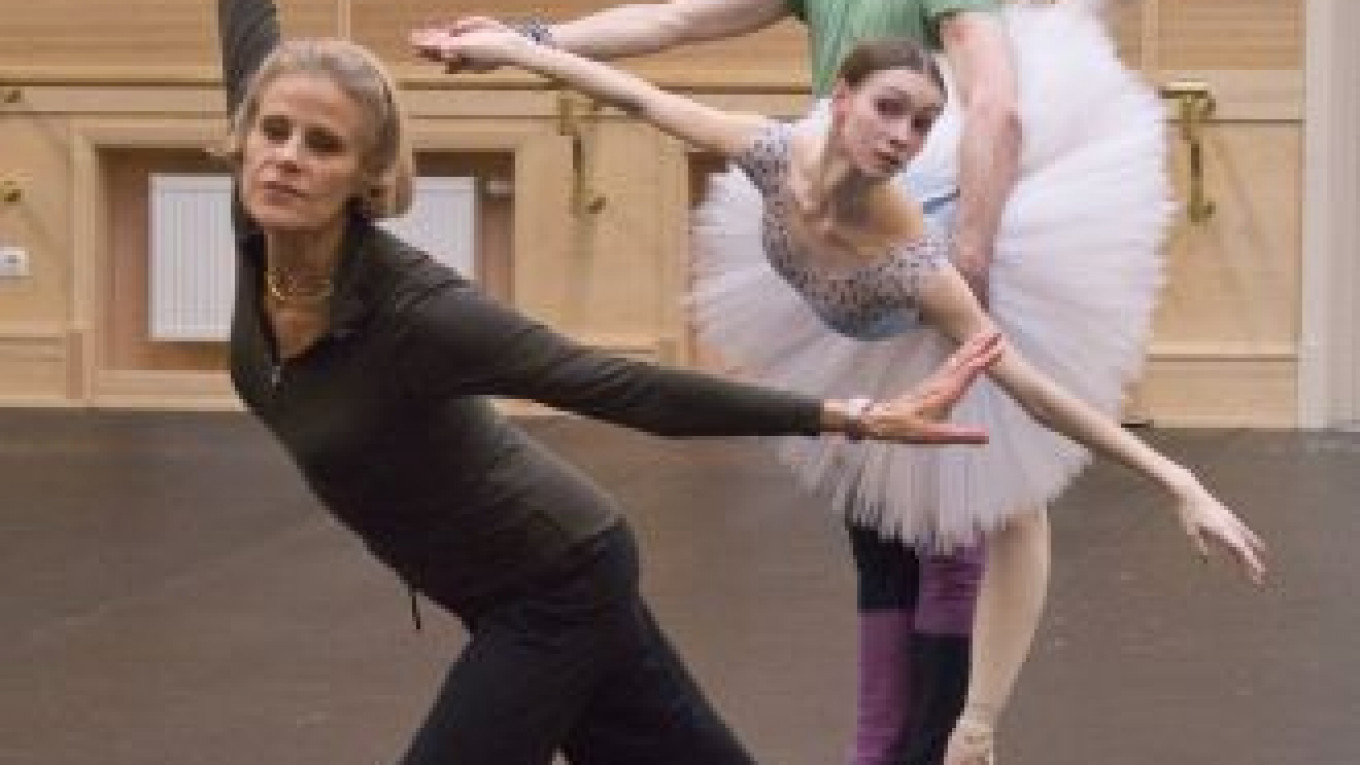The Bolshoi Theater presents its second ballet premiere of the current season Saturday, George Balanchine's "Jewels," widely considered the first-ever full-length abstract ballet. Created 45 years ago for Balanchine's own New York City Ballet, it has subsequently been staged, in full or in part, by more than 60 other dance companies throughout the world.
Moscow had a brief look at "Jewels" when the Mariinsky Theater brought its production of the ballet to the Bolshoi not long before the theater's Main Stage was closed for reconstruction in 2005. And last season, the Bolshoi itself premiered "Rubies," the second of "Jewels'" three parts, though with entirely different sets and costumes from those to be seen tomorrow.
"Jewels" opens with "Emeralds," set to a pair of suites, "Pelleas et Melisande" and "Shylock," by French composer Gabriel Fauré. "Rubies," which follows, is danced to Igor Stravinsky's "Capriccio for Piano and Orchestra." And the finale, "Diamonds," employs all but the first movement of Pyotr Tchaikovsky's Symphony No. 3.
Balanchine developed a keen interest in precious stones through his acquaintance with the noted jeweler Claude Arpels. Nevertheless, despite using jewels for his titles, he denied that they really had anything to do with his ballet. "The dancers are just dressed like jewels," he said.
At a news conference last week, Merrill Ashley, one of the last ballerinas to be trained by Balanchine, who has come to Moscow, together with one-time New York City Ballet colleague Paul Boos, to stage "Diamonds," put forward at least one likely explanation of what Balanchine had in mind in creating "Jewels." "Each part," she said, "represents a different stage of Balanchine's career," "Emeralds" harking back to the decade he spent in France after leaving the Soviet Union in 1924, "Rubies," with its jazz-influenced Stravinsky score, a tribute to the United States, where he spent the remainder of his life, and "Diamonds" paying homage to Russia and the classical-dance "upbringing" he received in his native St. Petersburg.
The day before the news conference, I had a long conversation with Boos and yet another former NYCB ballerina, Sandra Jennings, who is here both to refurbish "Rubies," which she very successfully brought to the Bolshoi last season, and to stage "Emeralds."
"Putting on 'Jewels' is a huge undertaking," Jennings said, "and particularly with entirely new sets and costumes." "You have to have five extraordinary women dancers to pull it off," Boos added, "but the beauty of big companies like the Bolshoi is that you can find those dancers."
"I love working here," Jennings said, "the dancers are incredible. But I've had a big problem with scheduling. I rehearse certain dancers one day, and the next day some of them don't come to rehearsal. Then I'm told it's because they have a performance that night. In America, we're used to everybody always showing up for rehearsal, performance or no performance."
"Another problem," she said, "is that the dancers are exhausted. They're going, going, going all the time. I believe the Bolshoi really has to rethink how it does things. You can't do a big ballet like "Jewels," putting three or four casts together, and have so many performances of other ballets going on at the same time."
Turning to "Rubies," in particular, Jennings remarked that, when she returned to Moscow and took a look at it, "a lot of the dancing was 'off the music.' I'm trying to get it back 'on' again." "The dancers had lost the 'jazziness,'" Boos said. "They were uncomfortable with the movements, which are not natural to them, not in their DNA. We, as Americans, say 'look like Fred Astaire.' But they don't know who Fred Astaire is or what that sort of movement should be."
"Diamonds" is ballet on a more massive scale than either "Emeralds" or "Rubies." "Do you know how hard it is to stage 17 couples? 17 couples!" Jennings said. Boos agreed and noted that the finale "looks like New York's Grand Central Station at rush hour."
Despite the difficulties, both were optimistic about the outcome. "It's a wonderful company," Jennings said, "and they're going to do a great job."
Following the original premiere of "Jewels" in 1967, New York Times critic Clive Barnes summed up his impressions with this statement: "It is open to doubt whether even George Balanchine has ever created a work in which the inspiration was so sustained, the invention so imaginative or the concept so magnificent." I had the privilege of being present that first night and can think of no more eloquent way of expressing my own sentiments both then and at every performance of "Jewels" I have seen since.
"Jewels" (Dragotsennosti) plays Saturday, Sunday and May 5,6, 8, 9 and 10 at 7 p.m. at the Main Stage of the Bolshoi Theater, located at 1 Teatralnaya Ploshchad. Metro Teatralnaya. Tel. (499) 608-7317.
A Message from The Moscow Times:
Dear readers,
We are facing unprecedented challenges. Russia's Prosecutor General's Office has designated The Moscow Times as an "undesirable" organization, criminalizing our work and putting our staff at risk of prosecution. This follows our earlier unjust labeling as a "foreign agent."
These actions are direct attempts to silence independent journalism in Russia. The authorities claim our work "discredits the decisions of the Russian leadership." We see things differently: we strive to provide accurate, unbiased reporting on Russia.
We, the journalists of The Moscow Times, refuse to be silenced. But to continue our work, we need your help.
Your support, no matter how small, makes a world of difference. If you can, please support us monthly starting from just $2. It's quick to set up, and every contribution makes a significant impact.
By supporting The Moscow Times, you're defending open, independent journalism in the face of repression. Thank you for standing with us.
Remind me later.


